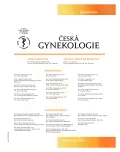Corifollitropin alfa in women stimulated for the first time in in vitro fertilization programme
Authors:
N. Vraná-Mardešićová; J. Vobořil; L. Melicharová; L. Jelínková; Š. Vilímová; T. Mardešić
Authors‘ workplace:
Sanatorium Pronatal, Praha, vedoucí lékař doc. MUDr. T. Mardešić CSc.
Published in:
Ceska Gynekol 2017; 82(5): 362-365
Overview
Objectives:
To compare results after stimulation with corifollitropin alfa (Elonva) in unselected group of women entering for the first time in in vitro fertilization programme (IVF) with results from Phase III randomized trials with selected groups of women.
Design:
Prospective study.
Setting:
Sanatorium Pronatal, Praha.
Methods:
40 unselected women with adequat ovarian reserve entering for the first time in IVF programme were stimulated with corifollitropin alfa and GnRH antagonists. Avarage age in the study group was 32,8 years (29–42 years), women younger then 36 and less then 60 kg received Elonva 100 µg , all others (age > 36 let, weight > 60 kg) Elonva 150 µg. Five days after egg retrieval one blastocyst was transferred (single embryo transfer – eSET). Our results were compared with the resuls in higly selected groups of women from Phase III randomized trials.
Results:
After stimulation with corifollitropin alfa and GnRH antagonists on average 10,6 (9,2 ± 4,2) eggs could be retrieved, among them 7,3 (6,6 ± 3,9) were M II oocytes (68,9%) and fertilisation rate was 84,6%. After first embryo transfer („fresh“ embryos and embryos from „freeze all“ cycles) 14 pregnancies were achieved (37,8%), three pregnancies were achieved later from transfer of frozen-thawed embryos (cumulative pregnancy rate 45,9%). There were three abortions. No severe hyperstimulation syndrom occured. Our results in unselected group of women stimulated for the first in an IVF programme with corifollitropin alfa are fully comparable with results published in randomized trials with selected group of patiens.
Conclusion:
Corifollitropin alfa in combination with daily GnRH antagonist can be successfully used in normal-responder patients stimulated for the first time in an IVF programme
Keywords:
corifollitropin alfa, GnRH antagonists, ovarian stimulation, pregnancy
Sources
1. Al Inany, HG., Youssef, MA., Aboulghar, M., et al. Gonadotropin-releasing hormone antagonists for assisted reproductive technology. Cochrane Database Syst Rev, (5), CD001750.
2. Baker, VL., Brown, MB., Luke, B. Association of number of retriever oocytes with live birth rate and birth weight: an analysis od 231,815 cycles of in vitro fertilization. Fertil Steril, 2015, 103, p. 931–938.
3. Boostanfar, R., Mannaerts, B., Pang, S., et al. A comparison of live birth rates and cumulative ongoing pregnancy rates between Europe and North America after ovarian stimulation with corifollitropin alfa or recombinant follicle-stimulating hormone. Fertil Steril, 2012, 97, p. 1351–1358.
4. Boostanfar, R., Shapiro, B., Levy, M., Rosenwaks, Z., et al. Large comparative, randomized double blind trial confirming noninferiority of pregnancy rates for corifollitropin alfa compared to with recombinant follicle-stimulating hormone in a gonadotropin-releasing hormone antagonist controlled ovarian stimulation protokol in older patiens undergoing in vitro fertilization. Fertil Steril, 2015, 104, p. 94–103.
5. Briggs, R., Kovacs, G., MacLachlan, V., et al. Can you ever colect too many oocytes? Hum Reprod, 2015, 30, p. 81–87.
6. Corifollitropin alfa Ensure Study Group. Corifollitropin alfa for ovarian stimulation in IVF: a randomized trial in lower-body-weight women. Reprod Biomed Online, 2010, 21, p. 66–76.
7. Devroey, P., Boostanfar, R., Koper, NP., et al. A double-blind, non-inferiority RCT comparing corifollitropin alfa and recombinant FSH during the first seven days of ovarian stimulation using a GnRH antagonist protokol. Hum Reprod, 2009, 24, p. 3063–3072.
8. Fares, FA., Suganuma, S., Nishimori, K. Design of a long-acting follitropin agonist by fusing the C-terminal semence of the chorionic chorionic gonadotropin beta subunit to the follitropin beta subunit. Proc Natl Acad Sci USA, 1992, 89, p. 4304–4308.
9. Fauser, BC., Mannaerts, BM., Devroey, P., et al. Advances in recombinant DNA technology: corifollitropin alfa, a hybrid molekule with sustained follicle-stimulating activity and reduced injection frequency. Hum Reprod Update, 2009, 15, p. 309–321.
10. Fauser, BC., Decroey, P., Macklon, N. Multiple birth resulting from ovarian stimulation for subfertility treatment. Lancet, 2005, 365, p. 1807–1816.
11. Griesinger, G., Boostanfer, R., Gordon, K. Corifollitropin alfa versus recombinant follicle-stimulating hormone: an individual patient data meta-analysis. Reprod Biomed Online, 216, 33, p. 56–60.
12. Kolibianakis, EM., Collins, J., Tarlatzis, B., et al. Among patients treated for IVF with gonadotropins and GnRH analogues, is the probability of live birth dependent on the type of analogue used? Hum Reprod Update, 2006, 12, p. 651–671.
13. Sunkara, SK., Rittenberg, V., Raine-Fenning, N., et al. Association between the number of eggs and live birth in IVF treatment: an analysis of 400 135 treatment cycles. Hum Reprod, 2011, 26, p. 1768–1774.
14. Youssef, MA., van Wely, M., Aboulfoutouh, I., et al. Is there a place for colifollitropin alfa in IVF/ICSI cycles? A systematic review and meta-analysis. Fertil Steril, 2012, 97, p. 876–885.
Labels
Paediatric gynaecology Gynaecology and obstetrics Reproduction medicineArticle was published in
Czech Gynaecology

2017 Issue 5
Most read in this issue
- What is the risk of pelvic organ prolapse recurrence after vaginal hysterectomy with colporrhaphy?
-
Screening of endometrial NK cells in selected infertile patients
First part – Methods and current results - Selective feticide in monochorionic twin pregnancies with discordant fetal anomalies: management and outcome
- Endometriosis and quality of life
